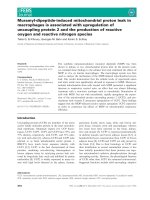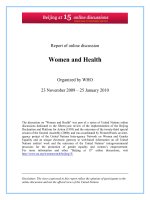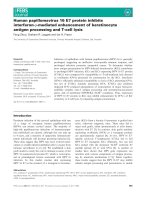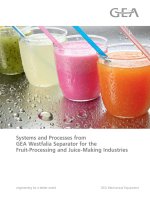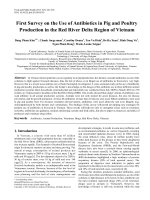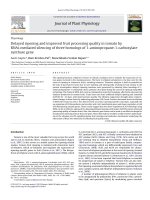REPORT OF PRACTICE OF VEGETABLE, FRUIT PROCESSING AND BEVERAGE PRODUCTION
Bạn đang xem bản rút gọn của tài liệu. Xem và tải ngay bản đầy đủ của tài liệu tại đây (575.58 KB, 71 trang )
HO CHI MINH CITY UNIVERSITY OF TECHNOLOGY AND EDUCATION
FACULTY OF HIGH QUALITY TRAINING
REPORT:
PRACTICE OF VEGETABLE, FRUIT
PROCESSING AND
BEVERAGE PRODUCTION
Lecturer in charge: M.Eng. Dang Thi Ngoc Dung
Class:
17116CLA
Student:
Ho Chi Minh city, April 2021
CONTENT
CONTENT OF TABLE
CONTENT OF FIGURE
LESSON 1. CANNED LONGAN JUICE PROCESSING
TECHNOLOGY
1. Overview
Sugar canned foods are processed from fruit (whole or sliced), through processing stages
(peeling, removing seeds, blanching, soaking in necessary chemical solutions, rinsing with clean
water ...), canning, filling with sugar juice, then air-treated (thermally or mechanically) and
capped, pasteurized, cooled. Due to the fast processing, the raw materials do not undergo much
heat treatment, so the product retains many of the original natural properties of the ingredients in
terms of color, flavor, status and nutrition. There are many sugar canned products on the market
such as apricots, pineapples, longan, lychee.
•
•
Classification of sugar canned products:
Based on the sugar content, people are classified into:
− Sugar canned food with extremely diluted sugar content: the solid content of sugar water from 10
−
−
- 14%.
Sugar canned food with diluted sugar content: the solid content of sugar water from 14 – 18%.
Sugar canned food with condensed sugar content: the solid content of sugar water from 18 –
22%.
− Sugar canned food with extremely condensed sugar content: the solid content of sugar water
above 22%.
• Based on the raw materials, we can distinguish 2 types of products:
− Made from one raw material. Fruits have different type of shape, such as leaving whole, sliced,
sliced, ... Products from one fruit are usually high-grade products, using a high-sugar soaking
−
solution.
Processed from a variety of ingredients. Usually in the form of a cube. Also known as a cocktail,
fruit salad or compote, the pickling has a lower sugar content. If the product consists of a mixture
of multiple fruits, the product name will be “mixed sugar juices”.
Among the juice cans, juices are the most popular because of their properties substance
similar to the fruit ingredient, especially in terms of color and flavor. Popular is water pineapple
sugar, sugared lychee, sugar water longan, mango sugar juice, sugar plum, pear sugar juice,
jackfruit sugar water. The popular mixed sugar juice is lychee with pineapple, rambutan and
pineapple. (N.V., at el., 2008)
4
Criteria for evaluating canned juice products
In order to assess the sensory quality of sugar-juice products, criteria were identified the
quality is mainly the color, taste, appearance, structure of the product and the clarity of the sugar.
Of those indicators, the flavor factor had the highest importance factor. In addition to the sensory
criteria, also identifies physicochemical criteria (dryness, acid content, net weight, fruit weight,
feet degree no, heavy metal content ...) and microbiological criteria.
•
In a box: the size, shape and color of the fruit pieces should be relatively similar evenly. The
•
product must be the natural color of the fruit used.
Status: firm, crunchy, porous, not smooth, the residual beneficial weight should not exceed 7%
•
•
•
by weight.
Taste: normal taste, no strange taste; has a characteristic taste of the fruit in use.
Syrup solution in the box: clear, free of impurities.
Box filling: the minimum fill level calculated by the amount of product contained in the box
•
must be 90%
The volume of distilled water is filled in sealed containers at 20oC.
2. Materials, tools, equipment and research methods
2.1. Materials
Fruit is the main raw material for the production of sugar-soaked canned fruit. Fruits need
to reach technical maturity, have a high hardness and crunch. Acidity is also a criterion for
selecting raw materials in the production process, in order to create sweetness and natural
harmony for the product. The fruits commonly used for sugar-soaked products can be lean fruits
such as mango, pear, apple, pineapple… are nuts such as peaches, apricots, plums, crocodiles,
clusters of intestines…; Less berries and citrus fruits are also used to create sugar-soaked fruit
products. In addition, people also use small fresh grapes or use dried grapes to reduce the water
content, increase the toughness of the product.
2.1.1. Longan
Longan (Dimocarpus longan Lour.) Is a subtropical fruit tree native to South East Asia.
This species is a member of the Portuguese family, a family that includes other fruit trees such as
litchi (Litchi chinensis Sonn.), Rambutan (Nephelium lappaceum L.), guarana (Paullinia cupana
Kunth), and Spanish lime. (Melicoccus bijugatus Jacq.), Ackee (Blighia sapida KD Koenig), or
pulasan (Nephelium mutabile Blume). (V.T. Pham, 2015).
5
Figure 1. Longan
•
Characteristics of raw materials:
Longan fruit (Dimocarpus longan Lour.) quite small (approximately 1.5–2 cm in
diameter), conical, heart-shaped or spherical and light brown in color. It has a thin, skinless, and
shiny film around the thick, succulent white flesh with a relatively large dark brown seed.
Maturity can be determined based on fruit weight, skin color, meat sugar concentration, meat
acidity, sugar: acid ratio, flavor or number of days since fruit. Longan fruit showed little change
in dissolved solids concentration (SSC) or acidity (TA) after harvest (Yueming Jiang, at el.,
2002).
•
Classify:
Longan is a precious fruit with many varieties and growing areas, throughout from the
North to the South, but concentrated in the Northern Delta and especially in the South.
•
Longan fruit pulp, thick skin, thick and dry pulp. Typical varieties are Pho Hien longan and the
area around Hung Yen town, harvested in September. The leaves are dark green, have little shade
or no shade, on average 8 - 10 leaflets, thick leaf blades, rippled, curled leaf edge, fruit weight
from 8.5 to 11.5 grams / fruit, fruit has a slightly flat shape, brown yellow skin, 4 - 5 mm thick
pulp, the ratio of pulp / fruit reaches 58%. Sweetness and aroma are behind the longan and the
alum sugar longan. Longan is mainly used for drying to make longan for export. The elite lines
•
are: TQ29, VT22, PHT99-1-3, YB29
Alum sugar longan has been grown for a long time in the bottom river area (old Ha Tay). The
color of the pods and pods are similar to those of a longan, but the fruit is round and smaller.
Fruit ripens 20-25 days later than longan. Average weight of fruit is 7 - 12 grams / fruit, the peel
is light brown and thick. The pulp is relatively thick, on the face there are small tumors such as
rock sugar, the juice has a slightly cloudy color, and has a sharp sweet taste. The rate of pulp /
•
fruit reaches 60%.
Longan has larger fruit than other varieties. The average weight of the fruit is 11-12 grams, about
14 - 15 grams / fruit large. The fruit on the longan cluster has uniform sizes. Characteristics of
the longan fruit is that the segments overlap at the top of the fruit, forming wrinkles on the outer
surface of the longan. Small longan seeds are dark brown in color, the grip between the pulp and
seeds as well as between the pulp and skin is relatively weak. The ratio of pulp / fruit reaches an
average of 62 - 63%. The ripe fruit is crispy and sweet.
6
•
Late longan (HTM) is the late ripe longan variety grown in old Ha Tay province, selected by the
Institute of Vegetable and Fruit Research and recognized as a technically advanced variety in
•
2005 and marked as (HTM-1)
Longan and similar breeds, large fruit, large seeds, watery pulp, sweet and fragrant. At present,
Southern longan growers can produce fruit and vegetables all year round. Golden rice canoe is a
breed with many prospects, good growth ability. Trees 15 - 20 years old have an average yield of
100 - 140 kg / tree / year. The fruit on the bunch is evenly large, the pods when ripe are yellow
cowhide, the average weight of the fruit is 15 - 16 grams / fruit, the pulp is yellowish white, the
•
pulp is from 5.5 to 6.2 mm thick. Lean, chewy, crunchy, sweet and fragrant, used to eat fresh.
Cow leather longan pepper like Hue pepper, gourd pepper, sugar pepper ... are popular varieties
of longan due to many advantages such as fast grown plants, high productivity, and easy
handling. off-season flowers, 2 years can give 3 crops of fruit. Trees 8 - 10 years old have an
average yield of 120 - 180 kg of fruit / tree / year. Ripe fruit has cow skin color, average fruit
weight is 8 - 12 grams / fruit, longan is milky white, 5 - 6 mm thick, slightly chewy, less water,
•
medium sweet, less fragrant.
Inert longan, water longan, thin pulp, sweet or light taste depending on the variety. This type has
no economic value, is rarely grown.
The longan fruit quickly deteriorates if the proper handling technique is not applied. The
main factors that reduce the shelf life and marketability of longan fruit are microbial rot and
browning of the longan fruit. Store at low temperatures at 1 – 5°C is used to reduce rotting and
limit browning of the outer shell. Furthermore, the fruit spoils quickly when taken out of the cold
storage. In cold storage conditions, longan has a shelf life of about 30 days. Sterilization with
sulfur dioxide is the most effective post-harvest treatment to control browning in longan and is
widely used in commercial storage today. However, more and more consumers are opposed to
using this chemical. Fumigation is becoming increasingly important with the expanding export
market. Irradiation and heat treatment for disinfection on longan are considered alternatives to
pesticide treatment (Yueming Jiang, at el., 2002).
People often use luscious longan and alum-sugar longan to prepare sugar-sweetened
canned foods (because the water-based longan has a sweeter taste, but the soft and thin pulp is
easy to break when processing), and the diameter of the fruit should be above 21mm. However,
7
because the experimental conditions depend on the season of the longan, the experimental team
decided to choose the source of raw material, the cow skin pepper.
2.1.2. Sugar syrup
Water: Water needs to meet the water standards used for beverage products. Used to cook
syrup solution
Saccharose: It is used to cook pouring liquid. Many different types of saccharose can be
used depending on technology requirements or product cost. Commonly used to cook a liquid is
refined sugar (Refined extra RE or Refined sugar RS) or rock sugar. The requirement is that the
sugar used must make a solution that is colorless or light yellow in color, does not have a strange
odor, affecting the natural taste of the product.
The sugar solution introduced into the product has no preservative effect but is intended
only to improve the flavor and feces that increase the nutritional value of the product (Continued
N. V., et al., 2008).
Sugar syrup is one of the most important ingredients of soft drinks. It regulates and
harmonizes the sour taste and aroma of drinking water. Saccharose is often used during fruit
juice processing. Saccharose is a disaccharide with molecular formula C 12H22O11 in the form of
colorless, odorless transparent crystals that dissolves easily in water, has a sweet taste, and has
no strange taste. Because of these properties and because it is so popular, Saccharose is more
commonly used than other sugars.
Saccharose used is usually RE sugar or rock sugar with the following standards:
•
•
•
Humidity: < 0.25%
Sulfate ash: < 0.14%
Sugar content: > 99%
The requirement of the sugar of producing canned juice is to make a solution that is
colorless or light yellow in color, does not have a strange taste, affecting the natural taste of the
product.
2.1.3. Metal can
Materials after going through the processing stages will be put into metal packaging.
Products after sterilization, can be stored for a long time under normal conditions.
8
Features of metal packaging: Hard, light, good heat transfer, good tensile strength, light
insulation, but has poor chemical resistance, easy to corrode, metal can contaminate food.
Suitable for the sterilization process in product packaging.
The metal box is made of a thin sheet of steel, tinned and coated with organic material to
prevent food from directly contacting the metal. Metal box weighing 55 grams.
Packaging before use needs to be quality again and cleaned of stains, microorganisms in
the packaging and then quickly transferred to the place where the product is poured. Dust-prone
packaging during transportation and storage is washed out by soaking in a water bath and then
rinsed with hot water jets or steam spray. You can use dilute alkaline solution or soda to remove
impurities, sand, mineral oil still stuck in the box during processing and transportation. It is then
dried.
To ensure the safety of the quality and the safety of the product, it must be packed in a
sealed box, stored in a dry and cool place. The opening can be designed so that consumers can
easily open the box without any additional tools. Products contained in metal packaging also do
not require too strict mechanics in the transport process, compact. (Nguyen Tien Luc, 2016)
2.2. Tools and equipments
•
•
•
•
•
•
Eyelid transplant device
Basket, brass
Tin box
9
Sterilized system
Electric stove
Electric scale
2.3. Research Methods
2.3.1. Purpose
Learn the technology of producing sugar-based canned food. Investigate the effects of the
ratio of water and water on the quality and feel of the product.
2.3.2. Method of implementation
2.3.2.1. Canned longan juice processing technology
2.3.2.2. Process description
•
Step 1: Classifying and sorting: Select ingredients with just enough ripeness, nice color,
•
no spoilage and pests.
Step 2: Peeling and removing seeds
Purpose: Preliminary processing of raw materials, removing seeds.
How to do it: after washing it, peel it, use a spoon to get the seeds, but do not lose the existing
structure of the material.
•
Step 3: Washing
Purpose: To eliminate mechanical impurities such as soil, sand, dust and reduce microorganisms
in the shell of raw materials. Washing also aims to remove some of the harmful chemicals used
by agricultural techniques such as pesticides.
Method: Soak in the tap water 2 - 3 times to remove dirt or pesticides on the material.
•
Step 4: Soaking in CaCl2
Purpose: To increase the sensory value and quality of the product.
Method: After pre-processing, soak the labels in 1% CaCl2 for 20 minutes, then rinse with clean
water and prepare for the next process.
•
Step 5: Putting in can and pouring syrup
Purpose: Perfecting products
10
Figure 2. Canned longan juice processing technology
Method: The labels are packed into the box. Syrup of sugar after cooking is put into a box with a
certain ratio, depending on the ratio to be investigated. When pouring sugar water, the
temperature should be between 80 and 85oC.
Changing: The osmosis process occurs, the water from the material comes out of the pouring
fluid, whereas the dissolved substances in the pouring fluid seep into the material.
Microorganisms are also inhibited in live activity due to osmotic pressure resulting from the
pouring solution.
Note: Do not fill the box, but must pour it from 5 - 10 mm from the top of the box. If you fill the
container with sugar water, during the pasteurization it may leak at the joints. The operation of
pouring sugar water must be fast, light, and free of air bubbles.
•
Step 6: De-aeration
Purpose: Expel the air from the box to limit the growth of aerobic microorganisms and fungi.
Method: Boil the water, then put the product into the box. Post about 10 - 15 minutes. If the
inspection is too long, it will create an undesirable odor such as cooking smell.
•
Step 7: Sealing
Purpose: Perfecting the product, preventing air from entering the bottle, reducing the growth of
some aerobic microorganisms.
•
Step 8: Pasteurization
Purpose: to kill food-causing pathogenic microorganisms and inhibit their toxin biosynthesis.
The pasteurization process does not significantly impair the nutritional and sensory value of the
food. However, after the pasteurization process, the microbiota in the food has not been
completely destroyed, especially the group of heat-tolerant microorganisms and microorganisms
capable of producing spores (Man, LV V et al.). , 2011).
Method: After eyelid transplantation, products are pasteurized at 105oC for 5 minutes.
•
Step 9: Cooling and storing the products
11
3. Results and discussion
3.1. Result
Calculation of ingredients for processing canned longan juice
We have the formula:
m1C1 + m2C2 = ΣmΣC
With: m1: weight of longan in can (g)
(1)
C1: oBrix of longan (C1 = 20)
m2: weight of syrup in can (g)
C2: oBrix of sugar (C2 = 22)
Σm = m1 + m2
ΣC: oBrix of the final products
From (1), we also have:
m1 × 20 + m2 × 22 = Σm × ΣC
(2)
Table 1. Brix results of canned longan samples
Ratio
m1 (g)
C1
m2 (g)
C2
Σm (g)
ΣC
Sample 1
5:5
179.12
20
180.88
22
360
21.00
Sample 2
5:5
185.05
20
184.57
22
379.62
21.21
Sample 3
5:5
194.38
20
199.87
22
394.18
21.02
Canned sugared water after storage, the Brix level of the samples decreased slightly,
because the Brix of the label is 20, lower than the Brix level of the sugar water (C2 = 22), so
when storing the sugar water, sugar will enter label (material balance), so the brix reduced in brix
after storage.
The label material that the group chooses is suitable for making canned sugars, because
after storage, the label retains its crisp, white, and clear brittle texture on all products. The best
ratio that our team saw after the survey was a ratio of 5: 5, the amount of water was enough to
cover the longan so the longan was evenly sweet, the sugar water was just sweet.
12
The longan is used as a canned product of regular sugar juice using only longan pulp and
rock sugar. Labels should be selected with pepper labels because the seeds are small and the
longan is thick and hard, will not soften or break when processed and sterilized, and can be used
with canoes. The diameter of the fruit should be over 21 mm. Sugar water can be used as refined
sugar or alum sugar, normally the sugar water label will use rock sugar. The requirement is that
the sugar used must create a solution that is colorless, has no strange odor and should not affect
the natural taste of the product.
3.2. Discussion
Out of a total of 3 samples that our team has made, perhaps sample 2 is the sample with the color
and brittleness of the label that is of the original quality set out. The remaining 2 samples, due to
the removal process, have not yet removed all the white flesh of the label, so they were black
after handling.
Figure 3. Canned longan product
•
Common problems and remedies
The label is soft. Fix: soak CaCl2, choose suitable label varieties.
13
The label darkens after storing. Fix: Avoid crushing the flesh of the fruit, carefully
examining it. Because when crushing the flesh, oxygen has conditions to come into contact with
the pulp.
The de-aeration step was not good, causing snuff when you opened the box. Solve:
remove air in boiling water, use chopsticks to gently tap on the side of the can to let the gas
escape, do not knock hard because the gas can go from outside to inside.
4. Reference
Yueming Jiang, Zhaoqi Zhang, Daryl C. Joyce, Saichol Ketsa. (2002). Review
Postharvestbiology and handling of longan fruit (Dimocarpus longan Lour.). Elsevier.
Lê Văn Việt Mẫn, Lại Quốc Đạt, Nguyễn Thị Hiền, Tôn Nữ Minh Nguyệt, Trần Thị Thu
Hà. (2011). Công nghệ chế biến Thực phẩm. Tái bản lần thứ 2. NXB Đại học Quốc gia TP Hồ
Chí Minh, Trường Đại học Bách Khoa. Trang 158.
V.T. Pham, M. H. (2015). Phenological growth stages of longan (Dimocarpus longan)
according to the BBCH scale. Elsevier.
Dawkins, N.L. and Nnanna, I.A. (1995) Studies on oat gum: composition, molecular
weight estimation and rheological properties. Food Hydrocolloids, 9(1). Pp 1 – 7.
Ganz, A.J. (1977) Cellulose hydrocolloids, in Food Colloids. AVI Press, Westport, CT. Pp
382 – 417.
Hart, B. (1988) Fixing formulations. Food Proc. (UK), 57(1). Pp 15 – 16, 21.
Hercules Inc. (1978) Cellulose awn - Chemical and Physical Properties, Hercules Inc.,
Wilmington, DE.
Jeanes, A.R., Pittsley, I.E. and Samtis, F.R. (1961) Polysaccharide B-1459: a new
hydrocolloid polyelectrolyte produced from glucose by bacterial fermentation. J. Appl. Polym.
Sci., 5. Pp 519 – 526.
Kovacs, P. and Kang, K.S. (1977) Xanthan gum. In Food Colloids. AVI Publishing,
Westport, CT. Pp 500 – 521.
14
Stelzer, G.I. and Klug, E.D. (1980) CarboxymethylceIIulose, in Handbook of Water
soluble Gums and Resins, ch. 4, McGraw-Hili, New York. Pp 4.1 - 4.28.
Urlacher, B. and Dalbe, B. (1992) Xanthan gum. In Thickening and Gelling
Agents/or Food. Blackie A & P, Glasgow. Pp 206 – 226.
LESSON 2. STRAWBERRY AND MANGO JAM PROCESSING
TECHNOLOGY
1. Overview of the product
1.1. Introduction
Jam is a sweet food, usually cooked from fruits or tubers of many types and each type of
jam has a different flavor depending on the ingredients and jam is a popular and familiar dish
with Vietnamese people on holidays or Tet holiday.
In Vietnam, there are dry jams like Tet jam, but in the West, people often use jam to eat
with breads or cakes.
1.2. Classification
Currently there are many jam products that consumers easily confuse, they almost have in
common is the use of sugar and pectin (Berino, 2020)
a) Jam
Jam is made from the meat of the fruit. Fruit is pureed into powder or ground and cooked
with sugar and pectin to make it soft and viscous. People often use fruits with a thickness and
succulent meat like strawberries, grapes, cherries, blueberries, and raspberry, so jam is usually
the thickness of fresh fruits.
b) Jelly
Figure 4. Jam
15
Jelly is made with the juice of the fruit then add sugar and pectin ... Therefore, jelly is
usually clearer and smoother than jam and can be used with herbs, tea, ... even wine to make
jelly instead of fruit.
c) Preserves
Figure 5. Jelly
Preserves are products which the fruit flesh is cut into small pieces, not puree like jam or
pressed into water like jelly. These fruit pieces are usually a mixture that is poured into jam or
jelly.
d) Fruit spread
Fruit spread is jam or preserves but only fruit, no sugar. Fruit spread is for whom eat a
Figure 6. Preserves
sugar diet or do not like sweet.
e) Marmalade
Marmalade is a new type of jam that is commonly used for citrus fruits (such as oranges,
Figure 7. Fruit spread
lemons, tangerines, grapefruit, kumquats, etc.) in which the fruit and peel are thoroughly cooked
with sugar into jam without using pectin.
1.3. History of Jam
It is difficult to pinpoint when people first made a fruit spread. Ancient civilizations were
known to set a variety of foods in the sun to dry in order to preserve them for later use.
Figure 8. Marmalade
16
Preserving foods was a home-based operation until the nineteenth century. Even today,
millions of people make fruit preserves in their own kitchens. Whether in the home kitchen or in
a modern food processing plants, the procedure is essentially the same. Fruits are chopped and
cooked with sugar and pectin until a gel is formed. The jam or jelly is then packed into sterilized
jars (Volume 5)
In the 16th century, when Spain came to West India to invade in order to expand power,
then food supply for soldiers was a difficult condition. So, they thought of using sugarcane to
make jam as food for reserve during the war here. Today, jam is more widely used, but is still
popular in European and American countries.
1.4. Quality criteria
General requirements
The final product shall have an appropriate consistency, color and flavor consistent with
the type or ingredient used in mixed processing, taking into account the flavor of the added
ingredient or any substance. Other allowed coloring is used. The product should not contain any
common fruit-related defects.
Table 2. Composition of some fruits (FAO, 1970)
Type of jam
Jam made from berry fruits:
strawberry, raspberry…
Jam made from stone fruits:
apricot, peach…
The main ingredients:
Moisture content%
Sugar %
Vitamin C (mg/100g)
29.8
69
10 – 25
29.6
69.3
10 – 35
For mangoes: The dissolved solid content of the final product should be between 60% and
65% Brix or more (TCVN 10393:2014, 2014)
2. Ingredients and experimental methods
2.1. Ingredients and equipments
2.1.1. Ingredients
a) Strawberries
17
Strawberries should be harvested at the coolest part of the day. The appropriate ripening stage
for collection is determined by the area and intensity of the red color. Most varieties are
harvested when three-quarters of their surface has the characteristic color of the species. Fruit are
picked by plucking each fruit with the thumb and index finger. The stalk is retained on the fruit
about 1 cm long.
The strawberries used must be whole, fresh, clean (not washed) and free from rot, insect
attack, external moisture and odors or strange flavors (Tiêu chuẩn quốc gia, 2013)
Figure 9. Strawberry
Maximum storage time for strawberries at 0°C can be:
-
Strawberries with sepals and stalks:
+ For consumption in fresh fruit form: 3 days to 6 days.
+ For processing: 8 days.
-
Strawberries without a calyx and stalk: 3 days.
Table 3. Nutritional compostitions in fresh strawberry
Nutrients in 100 grams of strawberries
Calories
Water
Protein
Carbohydrate
Sugar
Fibre
Lipid
Vitamin C
Calcium
Iron
Unit
g
%
g
g
g
g
g
g
g
mg
b) Mango
Quality requirements (TCVN 9766:2013, 2013)
18
Figure 10. Mango
Value
32
91
0.7
7.7
4.9
2
0.3
58.8
16
0.4
Table 4. Quality criteria for fresh mango
Targets
Content
Clean, ripe, free of foreign particles, whole fruit
Firm flesh
Fresh fruit form
No black spots or black spots
No bruises
No insects or impurities
Does not have any strange odor or taste
Appearance
Taste, odor
Dry matter content for mangoes: 25% (TCVN 10393:2014, 2014)
Table 5. Nutritional compositions in fresh mango (Bộ Y tế Viện dinh dưỡng, 2007)
Nutrients in 100 grams of mangoes
Calories
Water
Protein
Carbohydrate
Sugar
Fibre
Lipid
Ash
Calcium
Iron
Unit
kcal
g
mg
g
g
g
g
mg
mg
mcg
Value
69
82.5
600
15.9
4.9
0
0.3
600
10
400
c) Pectin
Pectin is a plant cell-wall polysaccharide consisting of a linear chain composed of Dgalacturonic acid residues linked via a(1-4)-glycosidic bonds (Toman et al., 1976)
It is water-soluble and binds with sugar and fruit acid to form a gel. Adding pectin when
making jam or jelly also shortens or eliminates the cooking time, resulting in a fresher fruit
Figure 11. Pectin
flavour (Kraft Canada cooking)
d) Citric acid
19
Figure 12. Citric acid and its molecule
Citric acid in jams is one of the most common food preservatives and flavoring additives.
It can be found naturally in citrus fruits but is also manufactured. Its name is derived from the
fact that it’s an organic acid found in many fruits and vegetables, especially citrus fruits. Citric
acid is a concentrated powder that is prized for its sour flavor, preservative quality, and ability to
act as a pH buffer.
Citric acid is a favored acidulant primarily because it is fairly neutral in flavor and is used
to bring the pH of the fruit-sugar-pectin mixture to the point where the pectin will gel properly
(Persianutab, 2020)
Acid helps extract pectin from fruit during gentle simmering and helps the gelling
process, which will not take place unless the mixture is fairly acidic.
e) Sugar
Sugar enhances the strength of the gel by attracting some of the water away from the
pectin. In the absence of sufficient water, pectin molecules are more likely to unite with each
other. Sugar also acts as a preservative, firms the structure of the fruit, and helps the jam or jelly
hold its color and flavor (Anne Gardiner & Sue Wilson)
f)
Water
Water creates a crust, stabilizing viscosity and solubility of sugar and pectin. Besides,
water also contributes to the concentration process.
Water used for the jam production is based on QCVN 01-1:2018/BYT (QCVN 011:2018/BYT, 2018)
2.1.2. Equipments
Table 6. Equipments used in the lecture
1
2
3
4
5
6
7
Equipments
Scale
Analytical balance
Knife
Chopping board
Pot
Chopstick
Spoon
Quantity
All groups in class
All groups in class
2
2
2
2 couples
2
20
8
9
10
11
Jar
Buret
Beaker
Refractometer
8
1
4
1
2.2. Experimental methods
2.2.1. Purpose
Learning the jam production technology. Determining the effects of pectin and citric acid
to the quality of jam products. My group chose strawberry and mango in order to use the meat of
strawberries and mangoes to make jam.
2.2.2. Experimental layout method
Table 7. Composition of strawberries jam
Ingredients
Strawberries
Sugar
Pectin
Citric acid
1
2
3
100
100
100
60
60
70
1
4
1
0
0
0
Table 8. Composition of mangoes jam
4
100
60
1
1
Ingredients
1
2
3
4
Mangoes
100
100
100
100
Sugar
40
40
50
40
Pectin
1
4
1
1
Citric acid
0
0
0
1
o
- Using refractometer to check the dry matter content of the final product: 65 – 70 Brix satisfy.
- Using biuret, beaker to standardize acidity in each jam products.
21
2.2.2.1. Process diagram of jam production technology
Strawberries
Selecting, classifying
Water
Washing
Cutting
Stalks
Pressing
Waste
Filtering
Sugar, citric acid
Mixing
Concentration
Jar
Filling
Labeling
Storing
Jam
Figure 13. Jam processing technology
22
Pectin
2.2.2.2. Explaination
a) Selecting and classifying
- Purpose: Select and classify raw fruits according to size, maturity and eliminate substandard
fruits such as pests, diseases, crushing, and spoilage before being put into production.
- Changes: The process of classifying the fruits will be uniform in terms of ripeness and spoilage.
b) Washing
- Purpose: Eliminate dirt, impurities, soil and sand sticking on fruit peel, part of microorganisms
and chemicals on the surface of fruit peel.
- Changes: Fruits after washing dirt and reducing the amount of microorganisms on the surface
of the skin, limit undesirable effects on the quality of the product.
c) Cutting
- Purpose: Eliminate any parts that are unusable and have no nutritional value such as the peel
and stalk of a raw material. Remove damaged parts that affect the quality of the product.
- Changes:
+ Pineapples will be changed in shape, size, and weight.
+ The respiratory rate of pineapple increases rapidly, leading to quick corruption of the fruit.
+ The exudate secreted on the surface is the cause of the rapid increase in oxidation, causing the
fruit to become dark and less attractive.
d) Pressing
- Purpose: Small ingredients, break the cell layer, support and increase the efficiency of the
scrubbing process.
- Changes: Ground fruits change shape, size, cell membranes are broken, cytoplasm and
intracellular enzymes are released, biochemical reactions take place easily. And this is also a
favorable environment for microorganisms to grow and spoil the pineapple after crushing.
e) Mixing
23
- Purpose: Adjust the chemical composition of the product, creating appropriate sensory values
for the product.
- Changes: Ground fruits will be mixed with sugar and citric acid thus changing the chemical
composition compared to the original.
f) Concentration process
- Purpose:
+ The process of concentration will increase the content of dry matter and solute in the product,
thereby increasing the nutritional value of the product, prolonging the product's preservation time
and efficiency.
+ Reducing volume of raw materials, reducing costs in packaging, transporting and taking
advantage of contained packages.
Prepare to coagulate, causing the pectin to stretch.
- Changes:
+ The material is reduced in weight due to water evaporation.
+ The color of the finished product may be darkened, or the odor of the product may be added
due to the Maillard reaction.
+ Biochemical reactions are completely suspended.
+ Microorganisms are inhibited due to high temperature and dry matter content.
g) Filling
- Purpose:
+ The temperature of the solution is high, reducing the viscosity so it is easy to pour into the box.
+ Eliminate air in the fluid and in the product out. Therefore, the reduction of oxygen in the
product before sealing has the effect of reducing oxidation, ensuring safety when storing canned
products.
+ Eliminate microorganisms in the product to reduce contamination and spoil the product.
24
Completely isolate the product from the outside environment, to avoid re-infection
microorganism.
- Boiling pectin before one day to make jam.
- The changes: Mainly the weight change, the concentrated solution is quantified into equal parts
according to the packing specifications.
h) Storing
- Purpose: Create a complete gel structure for the product. To keep the product stable in terms of
the proportion of nutrients in the canned food. Achieve a balance of the concentration of
substances, ensuring the ratio of water / fruit as required. Detect and promptly remove damaged
canned foods, deliver them safely, ensure quality and prestige.
- Changes: Form a gel structure by forming cross-links between polysaccharide fibers, and other
components locked in the gel network.
3. Results and discussion
Results
- pH results: 3.4 for strawberries jam, 3.94 for mangoes jam
- Acidity standardization results: takes 2 drops of phenolphtalein into the beakers having
reference sample and sample with citric acid.
Table 9. Strawberries jam standardization results
Figure 14. Standardization results of strawberries jam
25


